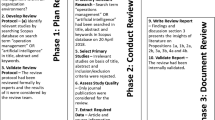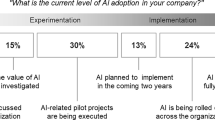Abstract
Artificial Intelligence has gradually materialized as an independent research field within information systems and business domains. The new forms of work evolving in the business require substantial experimentation, lead generations, and real-time recommendations. This has driven the extraordinary increase in the adoption of Artificial Intelligence technologies. Even with front runner organizations across the domain envisioning the advantages of early adoption of Artificial Intelligence technologies, some organizations scuffle the adoption owing to various barriers. This paper analyzes the characteristics that lead to and factors inhibiting the adoption of Artificial Intelligence at the organization-level. Through this paper, we report the results of Twitter conversations involving small and medium scale organizations about their level of adoption of Artificial Intelligence and barriers that they are facing. Through this analysis, we provide insights and agenda to help the executives of small and medium scale organizations to prepare for the adoption of Artificial Intelligence.
Access this chapter
Tax calculation will be finalised at checkout
Purchases are for personal use only
Similar content being viewed by others
References
Agrawal, A., Gans, J., Goldfarb, A.: The simple economics of machine intelligence. Harv. Bus. Rev., 17 November 2016
Lerner, S.: The evolution of artificial intelligence. Enterp. Digitalization, 11 February 2019
Gartner’s Top 10 Strategic Technology Trends for 2017. www.gartner.com/smarterwithgartner/gartners-top-10-technology-trends-2017
06-technology-background.pdf. https://www.calpers.ca.gov/docs/board-agendas/201801/full/day1/06-technology-background.pdf
PricewaterhouseCoopers: PwC’s Global Artificial Intelligence Study: Sizing the prize. PwC. https://www.pwc.com/gx/en/issues/data-and-analytics/publications/artificial-intelligence-study.html
Applying Artificial Intelligence to Drive Business Transformation: A Gartner Trend Insight Report
Alsheibani, S., Cheung, Y., Messom, C.: Artificial intelligence adoption: AI-readiness at firm-level, p. 9 (2018)
Perc, M., Ozer, M., Hojnik, J.: Social and juristic challenges of artificial intelligence. Palgrave Commun. 5(1), 61 (2019). https://doi.org/10.1057/s41599-0190278-x
Becker, L., Jaakkola, E.: Customer experience: fundamental premises and implications for research. J. Acad. Mark. Sci. 48(4), 630–648 (2020). https://doi.org/10.1007/s11747-019-00718-x
Kar, A.K.: Bio inspired computing – a review of algorithms and scope of applications. Exp. Syst. Appl. 59, 20–32 (2016). https://doi.org/10.1016/j.eswa.2016.04.018
McCarthy, J., Hayes, P.J.: Some philosophical problems from the standpoint of artificial intelligence. In: Webber, B.L., Nilsson, N.J. (eds.) Readings in Artificial Intelligence, pp. 431–450. Morgan Kaufmann (1981)
Lighthill, M.J.: Large-amplitude elongated-body theory of fish locomotion. Proc. R. Soc. Lond. B Biol. Sci. 179(1055), 125–138 (1971)
Miner, A.S., Laranjo, L., Kocaballi, A.B.: Chatbots in the fight against the COVID-19 pandemic. Digit. Med. 3(1), 65 (2020). https://doi.org/10.1038/s41746-0200280-0
Imerman, M.B., Fabozzi, F.J.: Cashing in on innovation: a taxonomy of FinTech. J. Asset. Manag. 21(3), 167–177 (2020). https://doi.org/10.1057/s41260-020-00163-4
Marín-Morales, J., et al.: Affective computing in virtual reality: emotion recognition from brain and heartbeat dynamics using wearable sensors. Sci. Rep. 8(1), 13657 (2018). https://doi.org/10.1038/s41598-018-32063-4
Kushwaha, A.K., Kar, A.K., Vigneswara Ilavarasan, P.: Predicting information diffusion on Twitter a deep learning neural network model using custom weighted word features. In: Hattingh, M., et al. (eds.) I3E 2020. LNCS, vol. 12066, pp. 456–468. Springer, Cham (2020). https://doi.org/10.1007/978-3-030-44999-5_38
Topol, E.J.: High-performance medicine: the convergence of human and artificial intelligence. Nat. Med. 25(1), 44–56 (2019). https://doi.org/10.1038/s41591-018-0300-7
Rogers, E.M.: Diffusion of innovations: modifications of a model for telecommunications. In: Stoetzer, M.W., Mahler, A. (eds.) Die Diffusion von Innovationen in der Telekommunikation. Schriftenreihe des Wissenschaftlichen Instituts für Kommunikationsdienste, vol. 17, pp. 25–38. Springer, Heidelberg (1995). https://doi.org/10.1007/978-3-642-79868-9_2
Pierce, J.L., Delbecq, A.L.: Organization structure, individual attitudes and innovation. AMR 2(1), 27–37 (1977). https://doi.org/10.5465/amr.1977.4409154
Cebon, P., Love, E.G.: Why do late adopters perform poorly: symbolic adoption, or cultural incongruity? Acad. Manage. Proc. 2002(1), I1–I6 (2002). https://doi.org/10.5465/apbpp.2002.7518359
Doherty, E., Carcary, M., Conway, G.: Migrating to the cloud: examining the drivers and barriers to adoption of cloud computing by SMEs in Ireland: an exploratory study. J. Small Bus. Enterp. Dev. 22(3), 512–527 (2015). https://doi.org/10.1108/jsbed-05-2013-0069
Cennamo, C., Marchesi, C., Meyer, T.: Two sides of the same coin? Decentralized versus proprietary blockchains and the performance of digital currencies. AMD (2020). https://doi.org/10.5465/amd.2019.0044
Sadhya, V., Sadhya, H.: Barriers to adoption of Blockchain technology. In: AMCIS 2018 Proceedings, August 2018
Pankomera, R., van Greunen, D.: Opportunities, barriers, and adoption factors of mobile commerce for the informal sector in developing countries in Africa: a systematic review. Electron. J. Inf. Syst. Dev. Ctries. 85(5), e12096 (2019). https://doi.org/10.1002/isd2.12096
Arif, I., Aslam, W., Hwang, Y.: Barriers in adoption of internet banking: A structural equation modeling - neural network approach. Technol. Soc. 61, 101231 (2020). https://doi.org/10.1016/j.techsoc.2020.101231
Cox, B., Ghoneim, S.: Drivers and barriers to adopting EDI: a sector analysis of UK industry. Eur. J. Inf. Syst. 5(1), 24–33 (1996). https://doi.org/10.1057/ejis.1996.9
Mergel, I.: Open innovation in the public sector: drivers and barriers for the adoption of Challenge.gov. Pub. Manage. Rev. 20(5), 726–745 (2018). https://doi.org/10.1080/14719037.2017.1320044
Ransbotham, S., Kiron, D., Gerbert, P., Reeves, M.: Reshaping Business With Artificial Intelligence: Closing the Gap Between Ambition and Action. MIT Sloan Management Review; Cambridge, vol. 59, no. 1 (2017)
Kruse, C.S., Kristof, C., Jones, B., Mitchell, E., Martinez, A.: Barriers to electronic health record adoption: a systematic literature review. J. Med. Syst. 40(12), 1–7 (2016). https://doi.org/10.1007/s10916-016-0628-9
Aswani, R., Ghrera, S.P., Kar, A.K., Chandra, S.: Identifying buzz in social media: a hybrid approach using artificial bee colony and k-nearest neighbors for outlier detection. Soc. Netw. Anal. Min. 7(1), 1–10 (2017). https://doi.org/10.1007/s13278-017-0461-2
Grover, P., Kar, A.K., Vigneswara Ilavarasan, P.: Blockchain for businesses: a systematic literature review. In: Al-Sharhan, Salah A., et al. (eds.) I3E 2018. LNCS, vol. 11195, pp. 325–336. Springer, Cham (2018). https://doi.org/10.1007/978-3-030-02131-3_29
Kumar, V., Umashankar, N., Kim, K.H., Bhagwat, Y.: Assessing the influence of economic and customer experience factors on service purchase behaviors. Mark. Sci. 33(5), 673–692 (2014)
Pine II, B.J., Gilmore, J.H.: Welcome to the experience economy. Harv. Bus. Rev. (1998). (From the July–August 1998 Issue)
Eisenhardt, K.M.: Making fast strategic decisions in high-velocity environments. AMJ 32(3), 543–576 (1989). https://doi.org/10.5465/256434
Grover, P., Kar, A.K., Dwivedi, Y.K., Janssen, M.: Polarization and acculturation in US Election 2016 outcomes – can twitter analytics predict changes in voting preferences. Technol. Forecast. Soc. Chang. 145, 438–460 (2019)
Kassarjian, H.H.: Content analysis in consumer research. J. Consum. Res. 4(1), 8–18 (1977). https://doi.org/10.1086/208674
Nooralahzadeh, F., Arunachalam, V., Chiru, C.-G.: 2012 presidential elections on Twitter – an analysis of how the US and French election were reflected in tweets. https://doi.org/10.1109/cscs.2013.72
Blei, D.M., Ng, A.Y., Jordan, M.I.: Latent dirichlet allocation. J. Mach. Learn. Res. 3, 993–1022 (2003)
Kar, A.K.: 5 Present-Day Applications of Artificial Intelligence – Tech Talk. https://techtalk.org/2018/02/16/5-present-day-applications-of-artificial-intelligence
Author information
Authors and Affiliations
Corresponding author
Editor information
Editors and Affiliations
Rights and permissions
Copyright information
© 2020 IFIP International Federation for Information Processing
About this paper
Cite this paper
Kushwaha, A.K., Kar, A.K. (2020). Micro-foundations of Artificial Intelligence Adoption in Business: Making the Shift. In: Sharma, S.K., Dwivedi, Y.K., Metri, B., Rana, N.P. (eds) Re-imagining Diffusion and Adoption of Information Technology and Systems: A Continuing Conversation. TDIT 2020. IFIP Advances in Information and Communication Technology, vol 617. Springer, Cham. https://doi.org/10.1007/978-3-030-64849-7_22
Download citation
DOI: https://doi.org/10.1007/978-3-030-64849-7_22
Published:
Publisher Name: Springer, Cham
Print ISBN: 978-3-030-64848-0
Online ISBN: 978-3-030-64849-7
eBook Packages: Computer ScienceComputer Science (R0)





